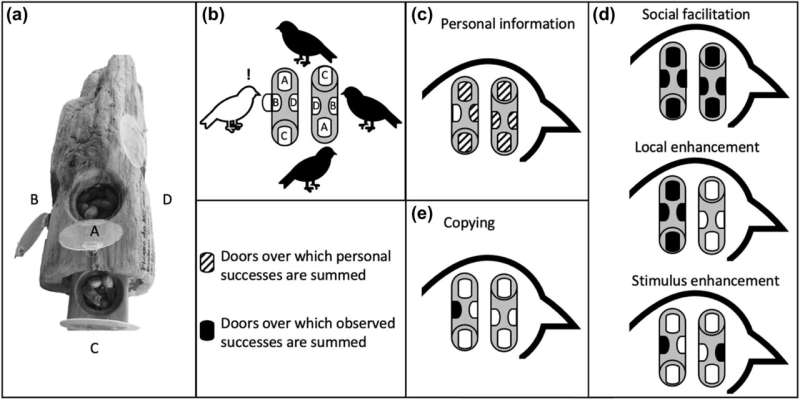Non-social jays surprise scientists by learning as skillfully as birds living in groups

The California scrub-jay, a generally non-social bird, can learn just as well as another species of jay that lives in groups, a finding that surprised animal intelligence researchers who devised a novel food puzzle to study cognition in the wild.
The research illustrates the complexity of the link between social behavior and the evolution of intelligence, say the scientists, who had expected the group-oriented Mexican jay to outperform the scrub-jay.
The international collaboration that included Oregon State University's Jonathon Valente was led by the University of California Santa Barbara's Kelsey McCune when she was at the University of Washington. Findings were published in Nature Scientific Reports.
"Further studies with wild animals are clearly necessary to develop a better understanding of when, where and why intelligence evolved," said Valente, a postdoctoral scholar in the OSU College of Forestry.
Scientists have long wondered why some wildlife species evolved with higher levels of intelligence than others, and a leading theory posits that animals living in groups tend to be smarter because they need cognitive abilities more complex than those required of less-social species, according to McCune.
"The group-oriented animals rely on intelligence to cooperate with and learn from—and also deceive—their group mates," she said. "However, due to the difficulty of testing cognition outside the laboratory, no studies to date have tested this theory in wild animals."
McCune, Valente and colleagues at Seoul National University and Daegu-Gyeongbuk Institute of Science, also in South Korea, put bird food behind four different types of doors on two identical puzzle apparatuses, each fashioned from a log. Three of the four doors had a simple lock; the other was unlocked but contained a less-desirable type of food—sunflower seeds rather than peanuts.
The researchers trained "demonstrator" birds of each species how to open a locked door and then set about looking at the learning abilities of wild, banded jays: 49 Mexican jays, which were studied near Portal, Arizona, and 26 California scrub-jays, observed in Oregon's Willamette Valley.
"Having an unlocked door helped prevent 'naïve' jays from abandoning the foraging area due to a failure to get food, thus increasing their probability of observing group mates interacting with the puzzle," Valente said.
Mexican jays and California scrub-jays are closely related, McCune notes—both feed on tree nuts like acorns, are opportunistic, generalist foragers that like dry, open habitats of pine and scrub oak, and cache food at a similar rate.
But they have very different social systems: Mexican jays assemble in groups of five to 30, while the relatively non-social scrub-jays mainly live with a single mate.
"We compared intelligence between these species by testing their abilities to either innovate a solution to the puzzle or to learn to solve the puzzle by observing other birds solving it," McCune said. "Contrary to what we thought we'd find out, the two species showed similar abilities to learn."
The scrub-jays and Mexican jays differed in the ways they preferred to learn, the researchers noted. Mexican jays tended to learn through watching other jays interact with the puzzle, whereas scrub-jays relied more on individual problem-solving to get at the food.
"Also, surprisingly, members of both species tended to avoid interacting with parts of the puzzle where they observed other birds obtain food," Valente said. "That suggests they were socially learning where to avoid competition rather than how to open the puzzle. Regardless, the findings suggest the relationship between social behavior and the evolution of intelligence is a highly complex one."
More information: Kelsey B. McCune et al, Social behavior mediates the use of social and personal information in wild jays, Scientific Reports (2022). DOI: 10.1038/s41598-022-06496-x
Journal information: Scientific Reports , Nature
Provided by Oregon State University




















